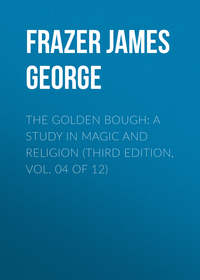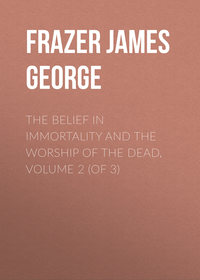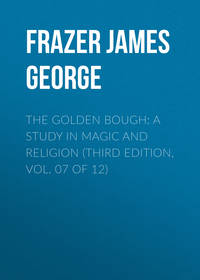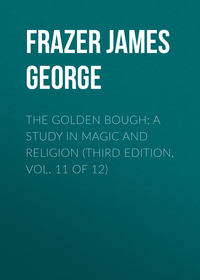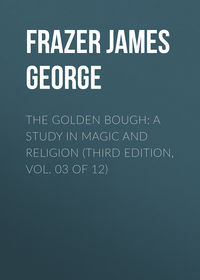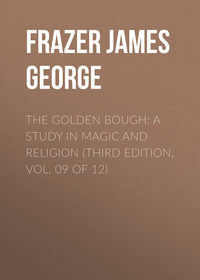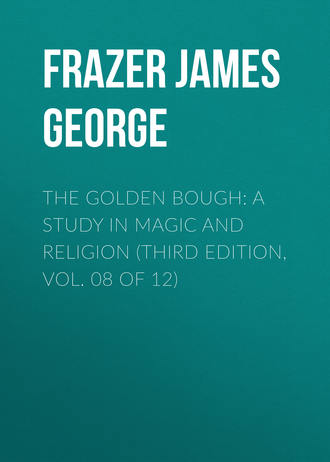
The Golden Bough: A Study in Magic and Religion (Third Edition, Vol. 08 of 12)
939
J. Brand, Popular Antiquities, iii. 194.
940
R. Chambers, Popular Rhymes of Scotland, New Edition (London and Edinburgh, n. d.), p. 188.
941
Ibid. p. 186.
942
P. Sébillot, Traditions et Superstitions de la Haute-Bretagne (Paris, 1882), ii. 214.
943
A. Bosquet, La Normandie Romanesque et Merveilleuse (Paris and Rouen, 1845), p. 221; E. Rolland, op. cit. ii. 294 sq.; P. Sébillot, l. c.; Rev. C. Swainson, op. cit. p. 42.
944
G. Waldron, Description of the Isle of Man (reprinted for the Manx Society, Douglas, 1865), pp. 49 sqq.; J. Train, Account of the Isle of Man (Douglas, 1845), ii. 124 sqq., 141.
945
In The Morning Post of Wednesday, 27th December 1911, we read that “the observance of the ancient and curious custom known as ‘the hunt of the wren’ was general throughout the Isle of Man yesterday. Parties of boys bearing poles decked with ivy and streamers went from house to house singing to an indescribable tune a quaint ballad detailing the pursuit and death of the wren, subsequently demanding recompense, which is rarely refused. Formerly boys actually engaged in the chase, stoning the bird to death with the object of distributing the feathers ‘for luck.’ ” From this account we may gather that in the Isle of Man the hunting of the wren is now merely nominal and that the pretence of it is kept up only as an excuse for collecting gratuities. It is thus that the solemnity of ritual dwindles into the pastime of children. I have to thank Mrs. J. H. Deane, of 41 Iverna Court, Kensington, for kindly sending me the extract from The Morning Post.
946
Ch. Vallancey, Collectanea de rebus Hibernicis, iv. (Dublin, 1786) p. 97; J. Brand, Popular Antiquities, iii. 195.
947
G. H. Kinahan, “Notes on Irish Folk-lore,” Folk-lore Record, iv. (1881) p. 108; Rev. C. Swainson, Folk-lore of British Birds, pp. 36 sq.; E. Rolland, Faune populaire de la France, ii. 297; Professor W. Ridgeway, in Academy, 10th May 1884, p. 332; T. F. Thiselton Dyer, British Popular Customs (London, 1876), p. 497; L. L. Duncan, “Further Notes from County Leitrim,” Folk-lore, v. (1894) p. 197. The custom is still, or was down to a few years ago, practised in County Meath, where the verses sung are practically the same as those in the text. Wrens are scarce in that part of the country, “but as the boys go round more for the fun of dressing up and collecting money, the fact that there is no wren in their basket is quite immaterial.” These particulars I learn from a letter of Miss A. H. Singleton, dated Appey-Leix, Ireland, 24th February 1904.
948
W. Henderson, Folk-lore of the Northern Counties (London, 1879), p. 125.
949
Rev. C. Swainson, op. cit. pp. 40 sq.
950
Madame Clément, Histoire des Fêtes civiles et religieuses, etc., de la Belgique Méridionale (Avesnes, 1846), pp. 466-468; A. De Nore, Coutumes, Mythes et Traditions des provinces de France (Paris and Lyons, 1846), pp. 77 sqq.; E. Rolland, Faune populaire de la France, ii. 295 sq.; J. W. Wolf, Beiträge zur deutschen Mythologie, ii. (Göttingen, 1857) pp. 437 sq. The ceremony was abolished at the revolution of 1789, revived after the restoration, and suppressed again after 1830.
951
E. Rolland, op. cit. ii. 296 sq.
952
C. S. Sonnini, Travels in Upper and Lower Egypt, translated from the French (London, 1800), pp. 11 sq.; J. Brand, Popular Antiquities, iii. 198. The “hunting of the wren” may be compared with a Swedish custom. On the 1st of May children rob the magpies' nests of both eggs and young. These they carry in a basket from house to house in the village and shew to the housewives, while one of the children sings some doggerel lines containing a threat that, if a present is not given, the hens, chickens, and eggs will fall a prey to the magpie. They receive bacon, eggs, milk, etc., upon which they afterwards feast. See L. Lloyd, Peasant Life in Sweden (London, 1870), pp. 237 sq. The resemblance of such customs to the “swallow song” and “crow song” of the ancient Greeks (on which see Athenaeus, viii. 59 sq., pp. 359, 360) is obvious and has been remarked before now. Probably the Greek swallow-singers and crow-singers carried about dead swallows and crows or effigies of them. The “crow song” is referred to in a Greek inscription found in the south of Russia ἕξ δεκάδας λυκάβας κεκορώνικα. See Compte Rendu of the Imperial Archaeological Commission, St. Petersburg, 1877, pp. 276 sqq. In modern Greece and Macedonia it is still customary for children on 1st March to go about the streets singing spring songs and carrying a wooden swallow, which is kept turning on a cylinder. See J. Grimm, Deutsche Mythologie,4 ii. 636; A. Witzschel, Sagen, Sitten und Gebräuche aus Thüringen (Vienna, 1878), p. 301; G. F. Abbott, Macedonian Folk-lore (Cambridge, 1903), p. 18; J. C. Lawson, Modern Greek Folklore and ancient Greek Religion (Cambridge, 1910), p. 35. The custom of making the image of the swallow revolve on a pivot, which is practised in Macedonia as well as Greece, may be compared with the pirouetting of the girl in the Servian rain-making ceremony. The meaning of these revolutions is obscure. See The Magic Art and the Evolution of Kings, i. 273, 275.
953
S. Johnson, A Journey to the Western Islands of Scotland, pp. 128 sq. (The Works of Samuel Johnson, LL.D., edited by the Rev. R. Lynam, London, 1825, vol. vi.).
954
John Ramsay, Scotland and Scotsmen in the Eighteenth Century (Edinburgh and London, 1888), ii. 438 sq. The custom is clearly referred to in the “Penitential of Theodore,” quoted by Kemble, Saxons in England, i. 525; Ch. Elton, Origins of English History (London, 1882), p. 411: “Si quis in Kal. Januar. in cervulo vel vitula vadit, id est in ferarum habitus se communicant, et vestiuntur pellibus pecudum et assumunt capita bestiarum,” etc.
955
J. G. Campbell, Witchcraft and Second Sight in the Highlands and Islands of Scotland (Glasgow, 1902), pp. 230-232. Shinty is the Scotch name for hockey: the game is played with a ball and curved sticks or clubs.
956
R. Chambers, Popular Rhymes of Scotland, New Edition (London and Edinburgh, n. d.), pp. 166 sq.
957
See above, vol. i. pp. 246 sq.
958
W. Mannhardt, Antike Wald- und Feldkulte (Berlin, 1877), p. 183.
959
O. Freiherr von Reinsberg-Düringsfeld, Fest- Kalender aus Böhmen (Prague, n. d., preface dated 1861), pp. 49-52. Compare E. Cortet, Essai sur les Fêtes Religieuses (Paris, 1867), p. 83. Similar processions with a Shrovetide Bear take place among some of the German peasantry of Moravia, though there the mummer is said to be wrapt in skins and furs rather than in straw and to personate Winter. See W. Müller, Beiträge zur Volkskunde der Deutschen in Mähren (Vienna and Olmütz, 1893), p. 431. This latter interpretation may be due to a misunderstanding of the old custom.
960
On this custom see The Magic Art and the Evolution of Kings, i. 137 sqq.
961
Real bears and other animals were formerly promenaded about both town and country with rags of coloured cloth attached to them. Scraps of these cloths and hairs of the animals were given, rather perhaps sold, to all who asked for them as preservatives against sickness and the evil eye. The practice was condemned by the Council of Constance. See J. B. Thiers, Traité des Superstitions (Paris, 1679), pp. 315 sq. We need not suppose that these animals represented the corn-spirit.
962
W. Mannhardt, Antike Wald- und Feldkulte, pp. 183 sq.
963
See above, vol. i. pp. 281 sqq.
964
W. Mannhardt, op. cit. p. 190.
965
W. Mannhardt, op. cit. p. 188.
966
W. Mannhardt, op. cit. pp. 191-193.
967
L. Lloyd, Peasant Life in Sweden (London, 1870), pp. 184 sq.; W. Mannhardt, op. cit. pp. 196 sq.
968
W. Mannhardt, op. cit. p. 196.
969
W. Mannhardt, op. cit. pp. 197 sq.
970
See above, vol. i. pp. 275, 298 sqq.
971
Letter of Professor G. C. Moore Smith, dated The University, Sheffield, 13th January, 1909.
972
R. Chambers, The Book of Days (London and Edinburgh, 1886), i. 94 sq.; J. Brand, Popular Antiquities, New Edition (London, 1883), i. 506 sqq.; T. F. Thiselton Dyer, British Popular Customs (London, 1876), pp. 37 sqq.; O. Freiherr von Reinsberg-Düringsfeld, Das festliche Jahr (Leipsic, 1863), pp. 27 sq. Compare W. Mannhardt, Baumkultus (Berlin, 1875), pp. 557 sq.; T. Fairman Ordish, “English Folk-drama,” Folk-lore, iv. (1893) pp. 163 sqq.; Folk-lore, viii. (1897) p. 184; E. K. Chambers, The Mediaeval Stage (Oxford, 1903), i. 208-210; H. Munro Chadwick, The Origin of the English Nation (Cambridge, 1907), p. 238. Counties in which the custom of Plough Monday is reported to have been observed are Norfolk, Cambridgeshire, Huntingdonshire, Northamptonshire, Lincolnshire, Leicestershire, Nottinghamshire, Derbyshire, Cheshire, and Yorkshire. Thus the custom would seem to have been characteristic of a group of counties in the centre of England. In January 1887, I witnessed the ceremony in the streets of Cambridge. Wooden ploughs of a primitive sort were dragged about by bands of young men who were profusely decked with scarves and ribbons. They ran at a good pace, and beside them ran a companion with a money-box collecting donations. Amongst them I did not observe any woman or man in female attire. Compare The Folk-lore Journal, v. (1887) p. 161.
973
See above, vol. i. pp. 25 sqq.
974
G. Kazarow, “Karnevalbräuche in Bulgarien,” Archiv für Religionswissenschaft, xi. (1908) pp. 407 sq.
975
G. Kazarow, “Karnevalbräuche in Bulgarien,” Archiv für Religionswissenschaft, xi. (1908) pp. 408 sq.
976
Major A. Playfair, The Garos (London, 1909), pp. 94 sq.
977
See above, p. 21.
978
See my note on Pausanias, viii. 37. 3 (vol. iv. pp. 375 sqq.).


